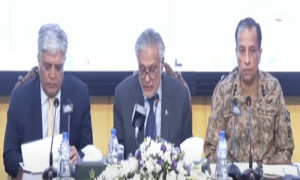Future of Pak-US relations

PAKISTAN’s long, close and turbulent relationship with the US has had a pervasive impact on this country’s history. The last phase of that relationship, the ‘war on terror’ alliance, ended in August 2017, when Donald Trump announced a punitive policy towards Pakistan, suspending high-level contacts, freezing Coalition Support Funds repayments and demanding Pakistan’s cooperation on Afghanistan.
Read: America suspends entire security aid to Pakistan
Over the next 18 months, America’s initially coercive demands on Afghanistan became progressively realistic, eventually asking Islamabad to help start direct talks between the US and the Afghan Taliban.
Pakistan has delivered on this request. Several rounds of US-Taliban talks, held mostly in Doha, have reportedly led to draft agreements for withdrawal of US troops from Afghanistan and to prevent Afghanistan’s territory from being used as a base for global terrorism in future. However, the Taliban have refused to talk to what they call the ‘puppet’ government in Kabul or to accept a ceasefire until US troop withdrawal is under way.
The US has not offered Pakistan any tangible concessions in exchange for its assistance. Contrary to earlier assurances that Islamabad would have no responsibility for the talks’ outcome, it is now asking that Pakistan play an important role in achieving a successful conclusion of the ‘peace process’.
US demands have been extended to the eastern front. During and after the Pulwama mini-crisis, US pressure was ratcheted up — directly and through the UN and the FATF — to demand actions against the Lashkar-e-Taiba and Jaish-e-Mohammad and the inclusion of JeM’s Maulana Azhar on the UN Security Council’s ‘terrorism’ list.
America’s new hostility towards Pakistan is due mostly to its emerging global rivalry with China.
Islamabad has seen it in its own interest to comply with the demands to proscribe the activities of the LeT and JeM. It has also continued its cooperation on Afghanistan. However, this may not prove sufficient to restore friendly ties with the US.
America’s new hostility towards Pakistan is due mostly to its emerging global rivalry with China, in which India has been chosen as Washington’s strategic partner whereas Pakistan is listed on China’s side of the power equation. The recently announced US South Asia Policy is predicated on India’s regional domination.
Read: Pakistan wants ‘proper ties’ with US like its relations with China
If Pakistan is to establish an equitable relationship with the US, it will have to build the capability to resist India-US military, financial and domestic pressure. To do so, it needs strong and nationally-oriented governance and China’s unreserved cooperation.
Pakistan is well placed to resist military pressure. The Pulwama mini-crisis demonstrated two things: one, that Pakistan can defend itself by conventional means; two, that nuclear deterrence worked once again to moderate military behaviour on both sides. Yet, India is embarked on a major arms acquisition and modernisation process which Pakistan will have to continue to neutralise if not match. Most importantly, Pakistan must disabuse India of any presumption that, under a US umbrella, it could ‘test’ Pakistan’s nuclear deterrence or resort to a pre-emptive strike against Pakistan’s strategic assets. A Pakistani ‘second strike’ capability will eliminate this danger.
Pakistan’s financial defences are vulnerable. The nation needs to come together to implement the politically difficult yet vital tax and other measures required to ensure a sustained balance in the country’s fiscal and external accounts. For the longer term, Pakistan should join the nascent efforts of China, Russia and some other countries to construct alternate or supplementary arrangements to the US-dominated financial system.
Likewise, Pakistan is not fully equipped to fight the ‘hybrid’ war being waged by India and others in Balochistan, ex-Fata, sections of the media and politics to destabilise the country domestically. Using all the tools of modern technology, Pakistan must develop a sophisticated intelligence, counter-insurgency and political action capability for defence.
‘Defensive’ measures do not imply systemic hostility with the US. There are vast areas for mutually beneficial cooperation which can be promoted as long as the US does not threaten Pakistan’s core interests and positions, especially its rejection of Indian domination and support for Kashmiri self-determination.
Counterterrorism, regional arms control and global non-proliferation are identified issues for continued cooperation.
Trade and investment are the most promising areas to build a future Pakistan-US relationship. The US is Pakistan’s prime export market. Pakistani exports are held back due to lack of competitive capacity. Pakistan’s current industrialization drive should target production for exports to the huge US as well as Chinese and Asian markets.
Similarly, even though US official assistance to Pakistan will be minimal and conditional, Pakistan should make a concerted effort to invite US private investment into the vast and untapped economic opportunities that exist in almost every sector of the Pakistan economy, including the SEZs and the privatisation programme. Apart from finance, such investment will bring advanced management techniques and production technologies to Pakistan.
Pakistan and the US also agree that there are vast opportunities for regional economic cooperation and integration, although their respective regional priorities are not yet fully convergent.
Despite the new Cold War, the US may find it expedient to cooperate with China and Pakistan to stabilise the Afghan economy in a post-settlement scenario, including through Afghanistan’s integration into CPEC, and collaborative execution of several agreed transnational projects, such as the TAPI and CASA-1000 ventures.
Pakistan’s revived relationship with Saudi Arabia and the UAE offers another avenue for indirect economic Pakistan-US cooperation. Significantly, Saudi and UAE investments in the energy and petrochemicals sectors, besides potentially building Pakistan’s bridges with US corporates, will also link them, via oil and gas exports, to China and Central Asia through Pakistan.
Hope resides in the possibility that the US will perceive the economic momentum in Asia, unleashed by the Belt and Road Initiative and Asian economic integration, as a strategic opportunity rather than a challenge. US participation could transform the Belt and Road endeavour into a globally beneficial enterprise.
Indeed, faced by global threats of climate change, poverty and nuclear annihilation, and offered the alternative of a cooperative, knowledge-driven future of growth and prosperity, the US, China, Russia and other powers, including India, ultimately would be wise to opt for ‘win-win’ cooperation rather than ‘lose-lose’ confrontation.
The writer is a former Pakistan ambassador to the UN.
Published in Dawn, May 12th, 2019














































